Understanding the Purpose and Design of Professional Embalming Facilities
An embalming-room is a specialized, sterile facility within funeral homes designed for the preservation and preparation of deceased individuals. This essential space combines medical-grade cleanliness with respectful dignity to serve families during their most difficult times.
Quick Overview: What is an Embalming Room?
- Purpose: Preserve bodies, restore natural appearance, allow extended viewing time
- Design: Hard surfaces (stainless steel, tile), medical-grade ventilation, restricted access
- Process: Arterial fluid injection, cavity treatment, cosmetic restoration
- Staff: Licensed embalmers and supervised apprentices only
- Timeline: 2-4 hours for standard cases, longer for restoration work
- Legal: Required in some states for interstate transport or delayed burial
The practice of embalming became widespread in America during the Civil War, when families needed a way to transport fallen soldiers home for proper farewells. Today's embalming rooms continue this tradition of helping families say goodbye with dignity.
Modern embalming serves multiple purposes beyond preservation. Psychologists agree that viewing the deceased helps loved ones begin healthy grief recovery, as noted in funeral industry research. The process also provides families time to plan services and allows distant relatives to travel for final goodbyes.
As we've worked with funeral homes across the country to design and equip professional preparation facilities, our experience helping funeral directors optimize their embalming-room layouts has shown us how proper equipment and design directly impact both staff efficiency and family satisfaction.
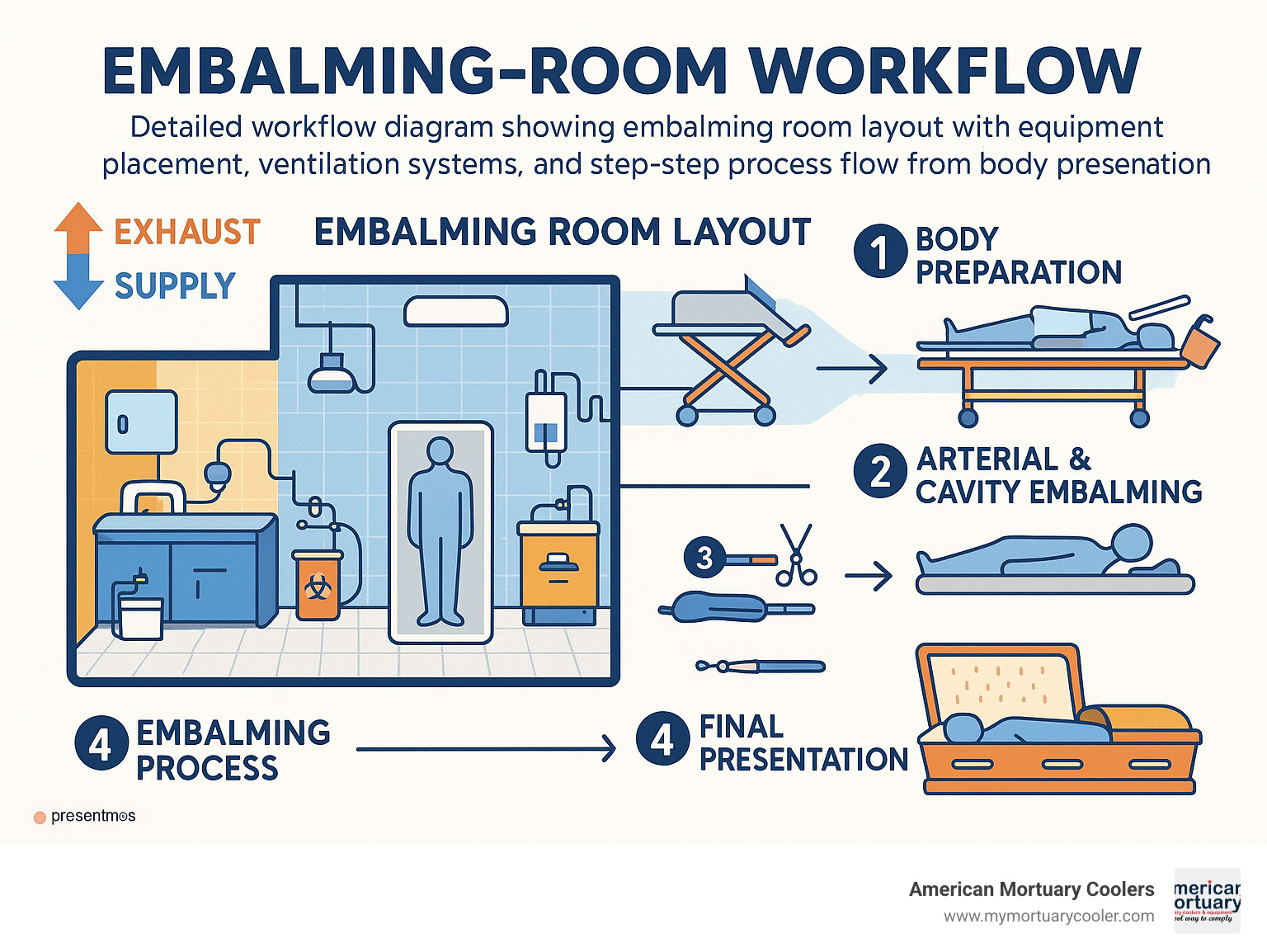
Designing a Modern Embalming Room: Layout, Materials & Access Control
When you step into a professional embalming-room, you'll notice it looks more like a hospital operating suite than anything else. Every surface, drain, and piece of equipment is carefully chosen to protect both the people working inside and the families they serve.
The foundation of any modern embalming-room starts with hard, non-absorbent surfaces that can withstand repeated cleaning with industrial-strength disinfectants. We're talking about stainless steel walls, sealed ceramic tile, and specially treated concrete floors that won't harbor bacteria or absorb chemical spills.
OSHA regulations and state health codes require specific design standards for these facilities. The room must operate under negative pressure ventilation to prevent formaldehyde vapors and other chemicals from drifting into other areas of the funeral home. Floor drains positioned throughout the space handle both planned drainage and unexpected spills safely.
Main Features & Surfaces
The walls in a professional embalming-room are typically covered with sealed ceramic tile or stainless steel panels from floor to ceiling. These materials resist chemical damage and can be thoroughly disinfected between cases.
Floor surfaces require special attention because they need to handle everything from embalming chemicals to biological fluids. Most funeral homes choose epoxy-sealed concrete or specialized mortuary flooring with a gentle slope toward strategically placed drains.
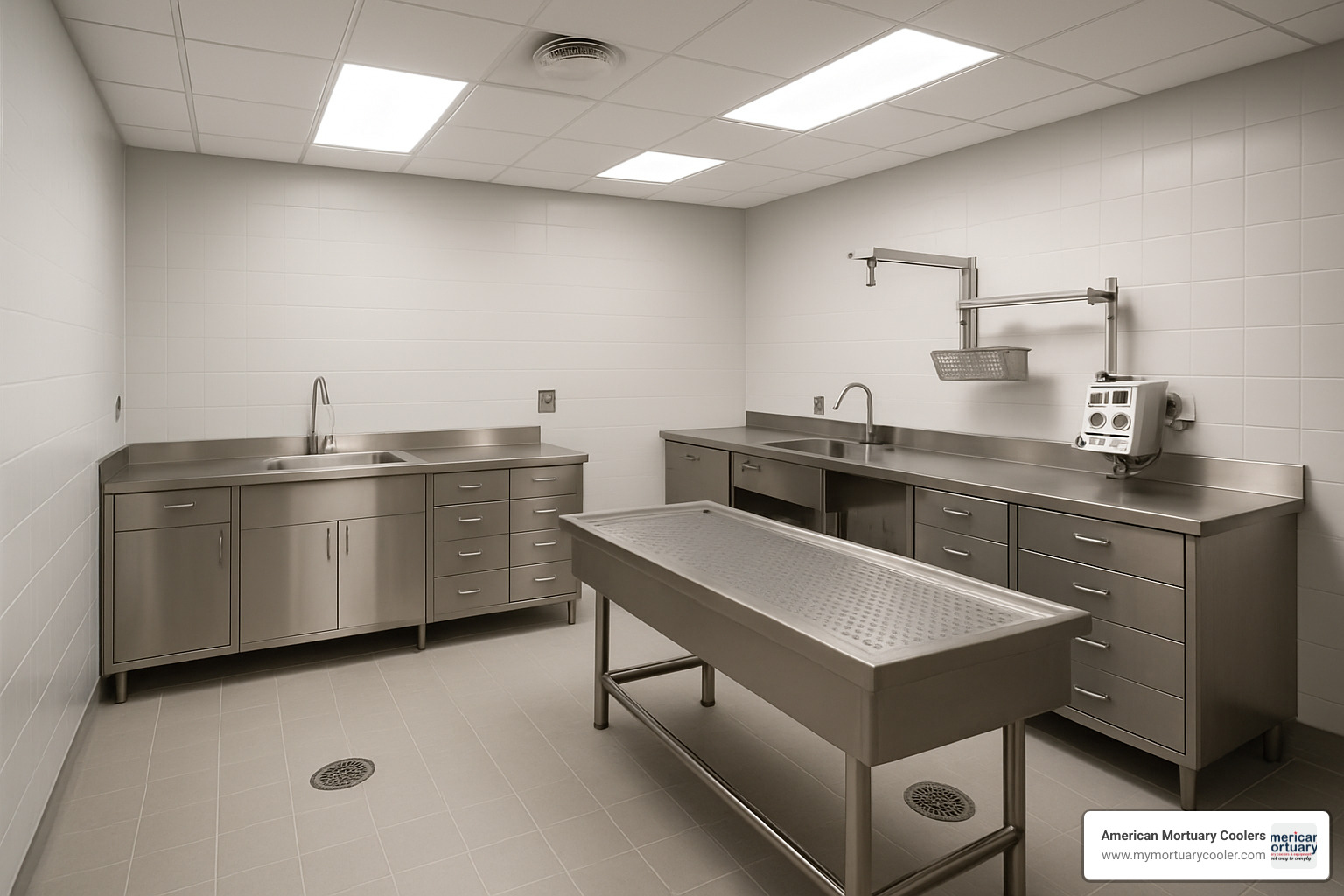
Lighting makes all the difference in this environment. Recessed LED fixtures provide bright, shadow-free illumination without the heat buildup of older bulb types. Many facilities add adjustable task lighting over work surfaces so embalmers can see fine details during cosmetic application and restoration work.
The centerpiece of any embalming-room is the stainless steel workstation. These feature integrated sinks, chemical storage compartments, and equipment mounting points. The design minimizes splash zones while keeping all necessary tools within easy reach.
Who Gets In and Why Restrictions Matter
Access to the embalming-room is strictly limited. Only licensed embalmers, supervised apprentices, and authorized health inspectors are permitted inside during normal operations.
Safety comes first in these restrictions. The room contains biohazardous materials and potentially dangerous chemicals that require specialized training to handle properly. Licensed professionals understand formaldehyde exposure limits, bloodborne pathogen precautions, and emergency procedures.
Confidentiality laws also play a major role in access control. These protections preserve the dignity of the deceased and their families while shielding funeral homes from legal liability. Chain-of-custody documentation tracks every person who enters the room.
Health inspectors and regulatory officials may need access during routine inspections. These visits are typically scheduled in advance and follow established protocols that maintain both security and respect for the space.
Family members are generally not permitted in the embalming-room during procedures. This policy protects both their emotional well-being and their physical safety.
Essential Equipment & Instruments: From Embalming Tables to Aspirators
Setting up a professional embalming-room requires a significant investment in specialized equipment. Costs can range from $838 for basic portable units all the way up to $21,995 for advanced autopsy and embalming stations.
The embalming table serves as the heart of the operation. These stainless steel surfaces are engineered with integrated drainage systems, adjustable height mechanisms, and often built-in scales for accurate documentation. Modern tables include tilt mechanisms and removable head rests that make different procedures easier to perform.
The embalming machine provides precise control over fluid delivery. Popular models like the Porti-Boy units give embalmers control over pressure and flow rates. These machines operate at pressures between 3-12 psi, carefully mimicking natural blood pressure to ensure proper fluid distribution. Safety features like pressure relief valves and flow meters prevent accidents.

Hydro-aspirators handle the removal of internal fluids and gases using water pressure to create powerful suction. The trocar - essentially a long, hollow needle - allows embalmers to access internal organs through small punctures. Arterial tubes and cavity injectors deliver preservative fluids to specific areas with surgical precision.
Personal protective equipment is mandatory in every embalming-room. This includes chemical-resistant gloves, protective eyewear, fluid-resistant gowns, and respiratory protection. Emergency equipment like eyewash stations and chemical spill kits must be within easy reach.
For a comprehensive look at all your equipment options, check out our A-Z Guide to Mortuary Prep Room Equipment Options.
Equipment Checklist for an embalming-room-
When setting up your embalming-room, certain pieces of equipment are essential. Stainless steel embalming tables with integrated drainage form the foundation, while chemical-resistant work surfaces and storage cabinets keep everything organized.
Your fluid delivery system needs an arterial embalming machine, along with pressure gauges, flow controls, and chemical mixing stations. Various tubing and connectors in different sizes are necessary.
For aspiration and drainage, invest in a quality hydro-aspirator with anti-clogging features and trocar tubes in multiple sizes. Your drainage collection systems and suction tubing need to handle whatever comes their way.
Hand tools include surgical scissors and forceps, suture materials and needles, cosmetic application brushes, and mouth formers with eye caps.
Safety equipment includes sharps disposal containers, chemical-resistant cleaning supplies, disinfectant sprayers, and first aid kits with spill response materials.
For specific guidance on choosing the right table, see our guide: Embalming Table 101: What It Is and How It's Used.
Safety, Sanitation & Ventilation Standards
OSHA regulations cover everything from formaldehyde exposure limits to bloodborne pathogen protection. Your ventilation system must provide at least 12 air changes per hour with proper makeup air to maintain negative pressure.
Personal protective equipment requirements include chemical-resistant gloves made from nitrile or neoprene, safety glasses with side shields, and fluid-resistant gowns or aprons. When formaldehyde levels approach regulatory limits, respiratory protection becomes mandatory.
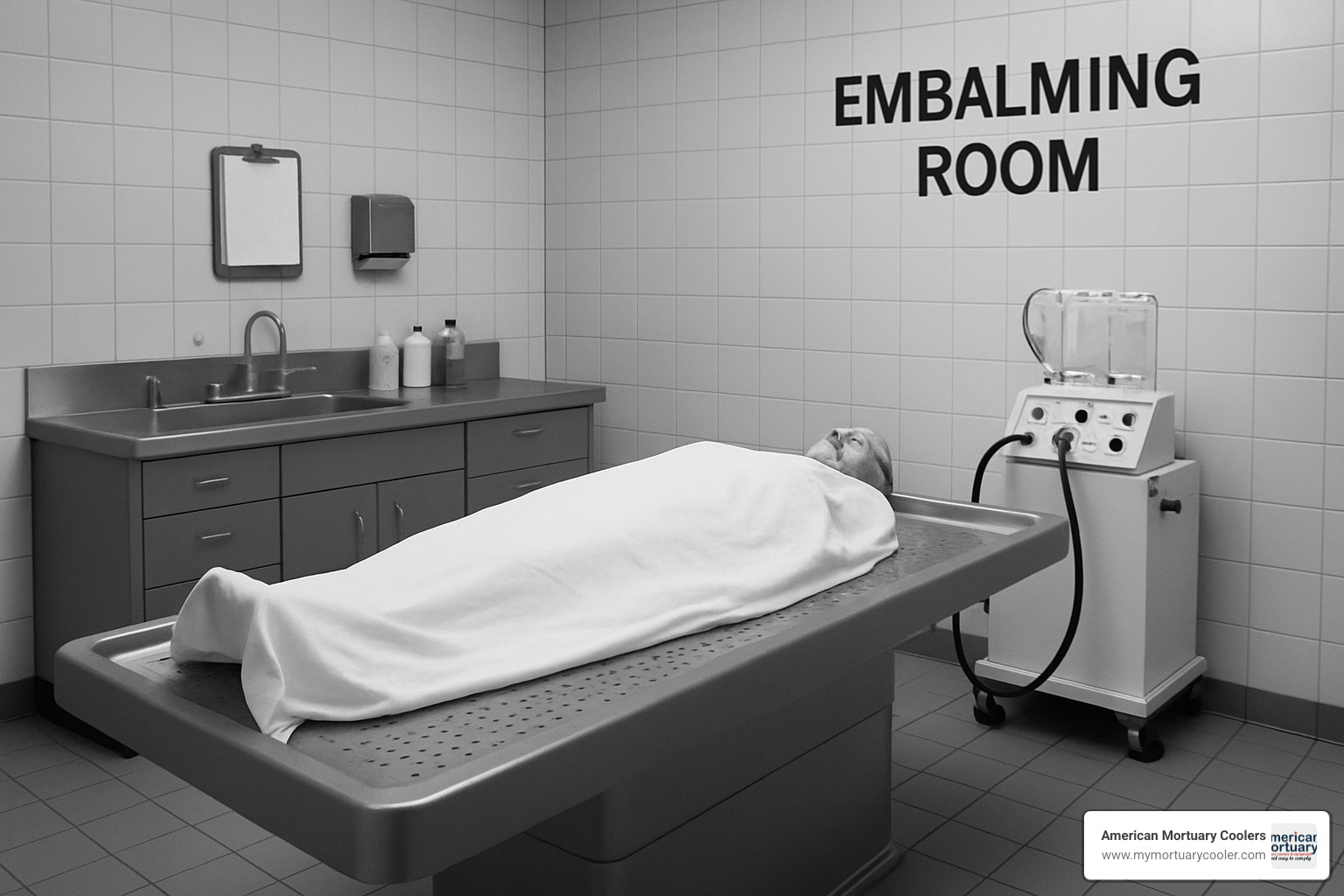
Emergency preparedness is crucial. Eyewash stations must be within 25 feet of chemical storage areas, while safety showers provide full-body decontamination capability. Spill response kits can mean the difference between a minor incident and a major problem.
Fire suppression systems need special consideration since they must handle both electrical equipment and chemical storage safely. Regular air monitoring ensures formaldehyde concentrations stay below OSHA's permissible exposure limit of 0.75 parts per million over an 8-hour period.
For comprehensive information about modern safety features, visit our resource on Essential Embalming Equipment: Modern Solutions Explained.
Comparing Embalming Fluids vs Refrigeration
| Factor | Embalming Fluids | Refrigeration |
|---|---|---|
| Preservation Time | 1-2 weeks for viewing | 3-7 days maximum |
| Cost Range | $150-400 per case | $50-150 per day |
| Chemical Exposure | Formaldehyde, other preservatives | None |
| Environmental Impact | Chemical disposal required | Energy consumption only |
| Viewing Quality | Restored natural appearance | Gradual deterioration |
| Legal Requirements | Required for interstate transport | Limited time restrictions |
| Religious Considerations | Prohibited by some faiths | Generally acceptable |
Inside the Embalming Process: Step-by-Step Workflow with Respect & Dignity
When a body arrives at the embalming-room, a carefully orchestrated process begins that balances scientific preservation with profound respect for human dignity. Every step follows strict protocols developed over decades to ensure families can say goodbye with peace and comfort.
The entire procedure typically takes 2-4 hours for standard cases, though complex restoration work may extend much longer. Throughout this time, professional embalmers maintain a reverent atmosphere, covering areas not being worked on and treating the deceased with the same respect they would want for their own loved ones.
Documentation starts before any hands-on work begins. Intake forms capture the deceased's identity, medical history, and any special requests from the family. A detailed embalming report tracks every step - fluid types, quantities used, unusual conditions encountered, and timing of each phase.
Preparation & Disinfection
The first hands-on step involves carefully removing and cataloging personal effects. Jewelry gets cleaned and documented piece by piece, medical devices are properly disposed of according to regulations, and clothing is handled with care for potential return to families.
A thorough germicidal wash comes next, eliminating surface bacteria and preparing the body for preservation. This includes shampooing the hair, cleaning under fingernails, and disinfecting all body openings with specialized antimicrobial sprays.
If rigor mortis has set in, the embalmer must gently work each joint to restore flexibility. This process, called "breaking rigor," starts with larger joints like shoulders and hips before moving to smaller ones in the hands and feet.
The final preparation step focuses on the face - the part families will remember most. Eyes are closed using specialized caps that maintain natural contours, while the mouth is positioned using internal supports or careful suturing techniques. The goal is always a peaceful, natural expression that brings comfort rather than distress.
Arterial & Cavity Treatment in the embalming-room-
Arterial embalming forms the heart of the preservation process. The embalmer makes small, precise incisions to access major arteries - usually the carotid artery in the neck or femoral artery in the thigh. Arterial tubes deliver preservative fluid while drainage tubes simultaneously remove blood, creating a controlled exchange.
The embalming machine becomes the artificial heart during this phase, circulating approximately three gallons of diluted preservative fluid throughout the circulatory system. Operating at pressures between 3-12 psi, it mimics natural blood pressure to ensure even distribution without damaging delicate tissues.
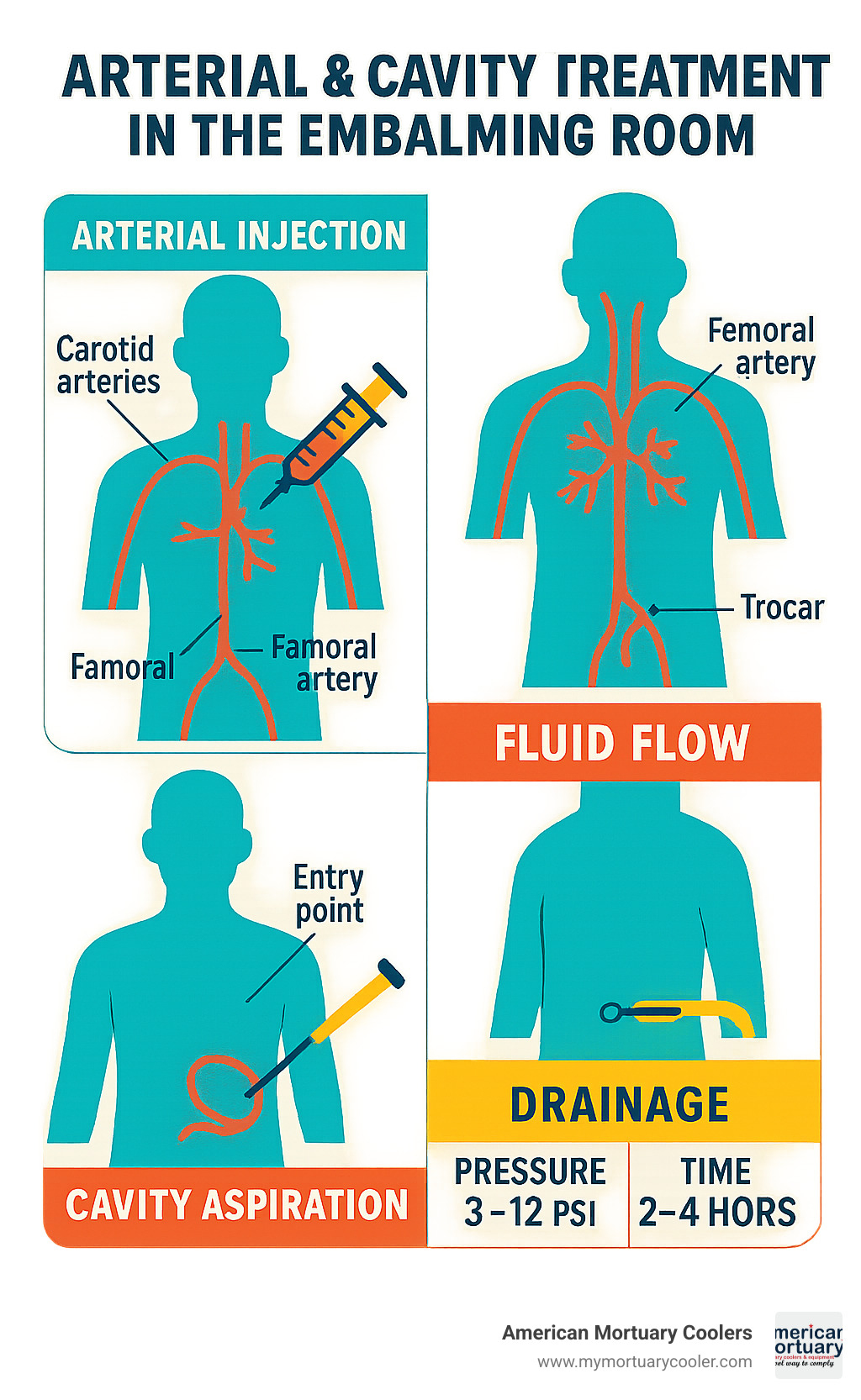
Once arterial treatment is complete, attention turns to the body cavities. Using a trocar - a long, hollow needle - the embalmer punctures the abdominal and thoracic cavities to aspirate internal fluids and gases. This step prevents internal decomposition that arterial fluid alone cannot reach.
Full-strength cavity fluid follows the aspiration, preserving internal organs and creating a complete preservation system. Modern embalming fluids contain formaldehyde as the primary preservative, along with humectants to prevent dehydration, pH buffers for stability, and dyes that help embalmers see their progress.
Cosmetics, Dressing & Final Presentation
The change from clinical preservation to comforting presentation requires both technical skill and artistic sensitivity. This final phase often determines whether families feel peace or distress when they see their loved one.
Color correction comes first, addressing any discoloration from illness, medications, or the embalming process itself. Mortuary cosmetics are specially formulated to work safely with preservative chemicals, unlike regular makeup that might react poorly or fade quickly.
Hair styling follows family preferences or cherished photographs they've shared. Many professional embalmers have cosmetology training specifically for this work. Fingernails are cleaned, trimmed, and sometimes polished to match the person's lifelong habits.

Dressing presents unique challenges that require specialized techniques and sometimes modified clothing. Hidden closures, specialty funeral garments, or careful alterations help maintain dignity while working within practical limitations. The goal is always making the person look like themselves on their best day.
Cultural and religious customs add another layer of complexity and meaning to this work. Some traditions require specific positioning, particular clothing, or special preparation methods. Professional embalmers work closely with families and religious leaders, ensuring every requirement is met with understanding and respect.
The embalming-room work concludes when the person looks peaceful and natural, ready for families to begin their goodbyes. It's technical work with a deeply human purpose - helping people we'll never meet say farewell to people they can't imagine living without.
Benefits, Alternatives & Evolving Trends
The decision to embalm isn't just about preservation—it's about giving families the time and peace of mind they need during one of life's most difficult moments. When we've worked with funeral directors across Tennessee, Georgia, and Illinois, we've seen how embalming-room services provide comfort that extends far beyond the technical aspects.
Research consistently shows that viewing the deceased helps families process grief more effectively. This visual confirmation of death, while initially difficult, aids in psychological acceptance and prevents complicated mourning that can interfere with healthy healing.
The practical benefits are equally important. Modern families often live scattered across the country, and embalming provides the time needed for everyone to gather. Insurance delays, military honors, or complex estate matters can push services out by days or weeks—situations where preservation becomes essential.
Some states legally require embalming for interstate transport or when burial is delayed beyond specific timeframes. These regulations protect public health while accommodating the reality that families don't always live where their loved ones pass away.
Why Families Choose Embalming
Emotional closure remains the most powerful reason families choose embalming services. The opportunity to see their loved one looking peaceful and natural provides immeasurable comfort during trauma. Many families describe this final viewing as transformative—a chance to say goodbye properly and begin healing.
The restorative capabilities of modern embalming can address conditions that might otherwise prevent viewing entirely. Skilled embalmers perform reconstructive work that allows families to say farewell even after severe accidents, extended illness, or other traumatic circumstances.
Logistical considerations often make embalming necessary rather than optional. Military families need time for official honors and coordination with veterans' cemeteries. Religious communities may require specific ceremonies that take time to arrange. Busy adult children scattered across time zones need flexibility to coordinate travel and work schedules.
For detailed information about recent legal developments and requirements, see Minnesota Embalming Rooms – legal insight.
Refrigeration, Green Burials & Other Options
Refrigeration offers a chemical-free alternative for families who prefer natural preservation methods. Modern mortuary coolers maintain precise temperatures between 36-40°F while controlling humidity to slow decomposition naturally. This approach works well for shorter timeframes, typically 3-7 days.
At American Mortuary Coolers, we've designed custom refrigeration solutions for funeral homes throughout our service regions. Our systems provide reliable temperature control while meeting health department requirements, giving families a dignified alternative to chemical preservation.
Green burial practices eliminate embalming entirely, focusing on natural decomposition in environmentally sensitive settings. These options have grown in popularity as families become more conscious of their environmental impact. The process typically involves biodegradable caskets or shrouds and burial in dedicated natural cemeteries.
Alternative preservation methods continue evolving to address environmental concerns. Alkaline hydrolysis, sometimes called water cremation, uses heat and alkaline solutions instead of traditional burial or cremation. Newer eco-friendly embalming fluids reduce formaldehyde content while maintaining preservation effectiveness.
Cost considerations often favor refrigeration for short-term needs, but embalming becomes more economical for extended preservation periods. The choice ultimately depends on family values, religious requirements, timeline needs, and local regulations.
Lessons Learned: Challenges, Innovations & Future Embalming-Room- Designs
Today's embalming-room operations face challenges that would have been unimaginable to earlier generations. The average body size has increased significantly, demanding upgraded lifting equipment and reinforced tables to protect staff from injury. Ergonomic considerations now drive room design decisions in ways that prioritize long-term staff health.
Medical advances create unique preservation challenges that require ongoing education and technique adaptation. Chemotherapy drugs affect how preservative fluids interact with tissues. New medications can alter blood chemistry in ways that impact the embalming process. Implanted medical devices require special handling protocols.
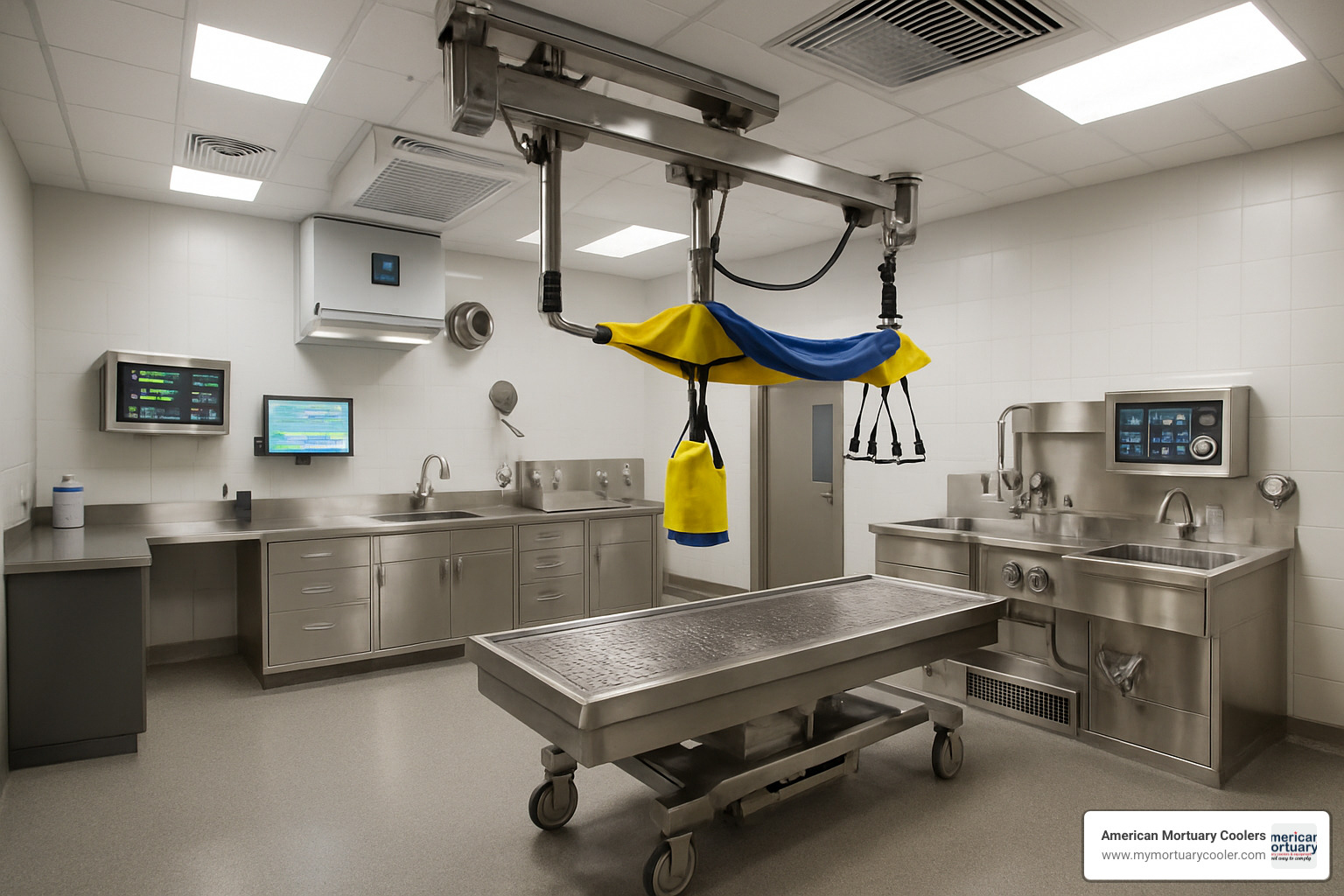
Environmental concerns drive innovation in formaldehyde alternatives and waste treatment systems. Smart ventilation systems automatically adjust airflow based on real-time chemical concentration monitoring, improving both safety and energy efficiency.
Staff wellness programs address both the physical and emotional demands of embalming work. Proper lifting techniques, strength training, and mental health support help embalmers maintain long, healthy careers.
Future embalming-room designs will likely incorporate more automation, improved chemical handling systems, and improved safety monitoring. Digital documentation systems already streamline record-keeping while reducing errors. Advanced lifting systems protect staff while improving efficiency.
For insights from practicing professionals about real-world challenges and solutions, read about experiences in Lessons learned from inside the embalming room.
These advances continue the profession's evolution toward safer, more efficient operations while maintaining the dignity and respect that families deserve during their most vulnerable moments.
Frequently Asked Questions about Embalming Rooms
When families are making difficult decisions during their time of loss, they often have practical questions about what happens in the embalming-room. These are three of the most common concerns we hear from families across our service areas.
Is embalming required by law?
The short answer is: it depends on where you live and your specific situation. No federal law requires embalming, but individual states have their own rules that can vary quite a bit.
Some states do require embalming when you're transporting a body across state lines or when burial gets delayed beyond a certain timeframe - usually somewhere between 24 to 72 hours. If you're planning a funeral that involves travel or might face delays, it's worth checking your state's specific requirements.
Most funeral homes require embalming for public viewings, but this is actually their business policy, not a legal requirement. You can often choose refrigeration instead if you're having a private viewing or if services happen quickly after death.
Religious considerations play an important role too. Many states provide exemptions for faiths that don't allow body modification. Jewish and Muslim traditions, for example, typically prohibit embalming and prefer burial within 24 hours when possible.
How long does the entire process take inside the room?
Most standard embalming procedures take 2 to 4 hours in the embalming-room. This includes all the preparation work, arterial injection, cavity treatment, and final cosmetic presentation that helps your loved one look peaceful and natural.
But every situation is different. Complex cases involving trauma, illness effects, or extensive restoration work can take much longer - sometimes 6 to 8 hours or even multiple sessions. The goal is always achieving results that bring comfort to families, even if it takes extra time.
Special circumstances can affect timing too. Things like autopsy preparation, organ donation coordination, or specific religious requirements might add time to the process. While funeral homes can sometimes accommodate rush situations, the quality of work might not be as thorough when normal timeframes get compressed.
Can families observe the procedure if they wish?
Most funeral homes don't allow families to observe embalming procedures, and there are good reasons for this policy. The embalming-room contains hazardous chemicals and biological materials that require special training to handle safely. Even with protective equipment, it's not a safe environment for untrained visitors.
Beyond safety concerns, the emotional impact can be overwhelming. The embalming process is highly technical and clinical - quite different from the peaceful final presentation families see later. Even people who think they're prepared often find the intermediate stages disturbing rather than comforting.
Professional embalmers work carefully to restore a natural, peaceful appearance, but this change happens gradually throughout the process. What families see during the procedure might actually interfere with the healing and closure they're seeking.
Some funeral homes might consider special requests for limited observation, particularly for educational purposes or specific cultural requirements. These situations need advance planning, extra safety measures, and clear understanding of what's involved.
Conclusion
Making decisions about embalming-room services during one of life's most difficult moments can feel overwhelming. That's why understanding how these specialized facilities work - from their medical-grade safety features to their respectful treatment protocols - helps families choose what feels right for their situation.
The story of embalming rooms stretches back to Civil War battlefields, where families desperately needed ways to bring their loved ones home. Today's modern embalming-room facilities carry forward that same mission of dignity and care, just with much better equipment and safety standards.
What hasn't changed is the heart of the work: helping families say goodbye in a way that brings comfort rather than additional pain. Whether that means preserving someone's appearance after a long illness, buying time for relatives to travel from across the country, or simply providing that final moment of peaceful closure, these facilities serve families when they need support most.
The funeral industry keeps evolving to meet changing needs. Environmental concerns are driving innovations in eco-friendly preservation methods. Technology improvements are making embalming rooms safer for workers and more efficient in their operations. Cultural awareness is helping funeral directors better serve diverse communities with varying traditions and beliefs.
At American Mortuary Coolers, we've seen how proper equipment makes all the difference in funeral home operations. Our custom mortuary coolers and embalming-room solutions help funeral directors across Tennessee, Georgia, Illinois, and throughout the country provide the professional, respectful services families count on during their darkest hours.
The choice between embalming, refrigeration, or other preservation methods should never feel rushed or pressured. Good funeral directors take time to explain options, answer questions honestly, and respect whatever decision feels right for each family's values, timeline, and budget.
Every person deserves a dignified farewell, and the modern embalming-room plays a crucial role in making that possible. These aren't just technical workspaces - they're places where science meets compassion, where skilled professionals work quietly behind the scenes to help families begin healing.
For more detailed information about preparation room design and refrigeration options, check out our comprehensive guide: More info about prep-room coolers.
Understanding what happens in an embalming-room removes some of the mystery from an already difficult process. Knowledge brings comfort, and comfort helps families focus on what matters most - honoring their loved one's memory and supporting each other through grief.
















